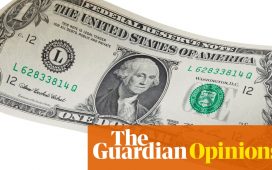Stay informed with free updates
Simply sign up to the US interest rates myFT Digest — delivered directly to your inbox.
Analysts have upgraded their forecasts for the US economy this year, bolstering hopes of a soft landing and bets that the Federal Reserve will delay interest rate cuts until the summer.
Strong growth in the final quarter of 2023 and the continued resilience of the US labour market in January have meant economists polled by Bloomberg now expect gross domestic product to expand by 2 per cent this year, about twice the pace they expected at the end of 2023.
“The US economy remains very robust and the main engine of global growth,” said Gregory Daco, chief economist at EY, who has recently raised his projection for 2024 from 1.8 per cent to 2.2 per cent. “There are headwinds, but overall there are no indications of an imminent retrenchment in the private sector.”
Most analysts now forecast that the Fed will make its first rate cut this year in either June or July, with three or four quarter-point moves in total by the end of the year. In January, the consensus was for six, beginning this month. Market expectations have also moved in line with those forecasts.
The brightening outlook is a mixed blessing for President Joe Biden, who is overseeing a booming economy — but at the expense, potentially, of the Fed feeling it needs to hold rates higher for longer, passing on higher borrowing costs to house and car buyers.
Fed chair Jay Powell will face a grilling from lawmakers on Capitol Hill this week, amid a growing acknowledgment in the market that the central bank will not rush to cut rates despite a fall in inflation from 7 per cent in 2022 to 2.4 per cent in January.
“Stronger growth could absolutely be something that lengthens the runway the Fed has to act,” said Ellen Zentner, chief US economist at Morgan Stanley.
Some analysts even think the economy’s enduring strength could mean the Fed holds off any rate cuts at all until the end of the year — especially if markets themselves do some of the job of easing capital costs by pushing down bond yields.
“If financial conditions continue to ease, growth will be strong, and the Fed will delay even further the first cut,” said Torsten Sløk of Apollo Global Management.
Powell will face questions from representatives in the House on Wednesday and senators on Thursday, with the Fed chair set to stress rate-setters’ caution in declaring victory over the worst bout of inflation for a generation.
He is also likely to reiterate that any cuts to borrowing costs from their 23-high of 5.25 per cent to 5.5 per cent will only happen once the central bank is confident it can hit its 2 per cent inflation goal.
The most recent report of Fed rate-setters’ own expectations came in December, and showed they expected the central bank to make three quarter-point cuts this year.
A fresh round of projections will be published after the next rate-setting vote on March 20. Some expect the Federal Open Market Committee to upgrade its 1.4 per cent GDP growth estimate for this year then too.
A recent month-on-month rise in the personal consumption expenditures index, an inflation gauge, and strong jobs numbers from January have supported the Fed’s reluctance to cut rates too soon.
“The backdrop is that more and more on the FOMC are becoming concerned that an easing of financial conditions might engender a re-acceleration of inflation,” said Zentner.
“If the economy comes in stronger than expected, I don’t think it means the Fed doesn’t cut at all, but it does mean the Fed will be very careful about delivering cuts.”
Behind the economy’s resilience, say analysts, is the willingness of consumers to keep spending — and few signs, yet, that a change in their mood is imminent.
“Consumers have a better balance sheet than we thought they would at the start of the year. We still expect there will be some slowdown, but it’s likely to be pushed back until the second half of the year,” said Satyam Panday, chief US economist at S&P Global Ratings.
Panday now believes the US economy will grow by 2.4 per cent this year, up from a November forecast of 1.5 per cent.
“As long as the jobs market is holding up, that gives us confidence that this strength in consumer spending is going to carry on for some time.”







